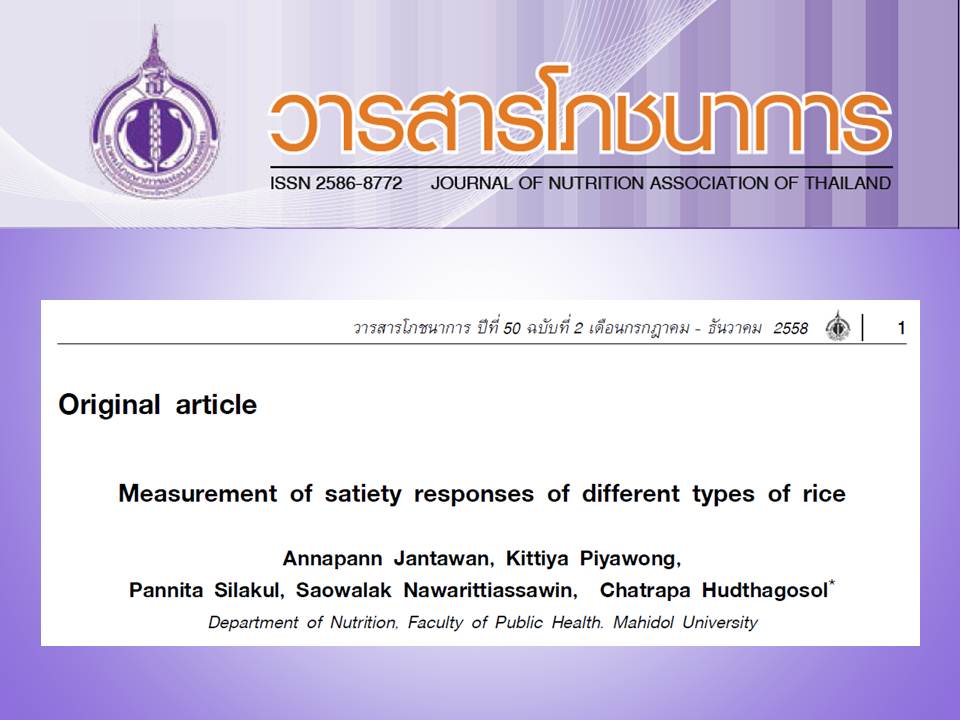Measurement of satiety responses of different types of rice
Abstract
Rice is a staple grain in Thailand, which is one of the world’s largest rice exporters. Recently, Thai researchers have developed a few new Thai rice strains with more nutritional values. Obesity has emerged as a major public health issue in Thailand, which mainly caused by excessive energy intake and lack of physical activities. This study was designed to investigate the effect of four different types of rice (White Jasmine rice, Sinlek rice, Riceberry rice, and Germinated Brown rice) on satiety responses (hunger, fullness, satisfaction, and desire to eat) and the effect of food intake at lunch. Twelve healthy women were studied in a within-subject preload with repeated measures, crossover design. Each participant completed four conditions, presented in random order. The test meals at breakfast containing 165 g of White Jasmine rice, Sinlek rice, Riceberry rice, or Germinated Brown rice. Pre and post-prandial satiety responded using 100 mm Visual Analog Scale (VAS) was measured at baseline (t-15), t0, t15, t30, t45, t60, t90, t120, t180, and t240 minutes. Energy intake was measure at the lunch using plate waste. There were no differences in the area under the time curve in modified VAS scores among types of rice in any parameter. However, the energy intake at lunch was significantly decreased in Riceberry rice compared to White Jasmine rice (p <0.01). All four types of rice were not differ significantly in the satiety response. Riceberry rice is the only rice that can decrease the energy intake at lunch.
References
2. Nam SH, Choi SP, Kang MY, Kozukue N, Friedman M. Antioxidative, antimutagenic, and anticarcinogenic activities of rice bran extracts in chemical and cell assays. J Agric Food Chem. 2005;53(3):861-62.
3. Kaneda I, Kubo F, and Sakurai H. Antioxidative compounds in the extracts of black rice brans. J Health Sci. 2006;52(5): 495-511.
4. Renuka DR, Arumughan C. Antiradicalefficacy of phytochemical extracts from defatted rice bran. Food Chem Toxicol. 2007;45:2014-21.
5. MCOT digitally beyond. Rice Berry, Sinlek: two new Thai rice breeds with more minerals. 2014 [cited 2014 August 31]. .Available from: https://www.mcot.net/site/content?id=4ff671540b01dabf3c00746a #.Vl5gQMscSUk.
6. Wu F, Yang N, Touré A, Jin Z, Xu X. Germinated brown rice and its role in human health. Crit Rev Food Sci Nutr. 2013;53(5):451-63.
7. Blundell J. Pharmacological approaches to appetite suppression. Trends Pharmacol Sci. 1991;12:147-57.
8. Green SM, Delargy HJ, Joanes D, Blundell JE. A satiety quotient: a formulation to assess the satiating effect of food.Appetite.1997;29(3):291-304.
9. Sørensen LB, Møller P, Flint A, Martens Mand Raben A. Effect of sensory perception of foods on appetite and food intake: a review of studies on humans. Int J Obes. 2003;27(10):1152-66.
10. Clark MJ, Slavin JL. The effect of fiber onsatiety and food intake: a systematic review. J Am Coll Nutr. 2013;32(3):200-11.
11. Nakornriab M, Sriseadka T, Wongpornchai S. Quantification of carotenoid and flavonoid components inbrans of some Thai black rice high performance liquid chromatography-mass spectrometry. J Food Lipids. 2008;15:488-503.
12. Chanphrom P. Antioxidants and antioxidant activities of pigmented rice and varieties and rice bran. MS [thesis].Bangkok: Faculty of Graduate Studies, Mahidol University; 2007.
13. Rosén LA, Östman EM, Björck IM. Effects of cereal breakfasts on postprandialglucose, appetite regulation and voluntary energy intake at a subsequent standardized lunch; focusing on rye products. Nutr J. 2011;10(7):1-11.

Downloads
Published
How to Cite
Issue
Section
License
Upon acceptance of an article, copyright is belonging to the Nutrition Association of Thailand.


